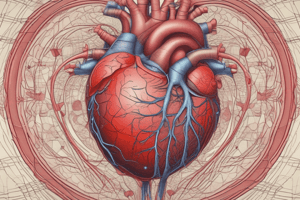Podcast
Questions and Answers
What happens to the velocity of water when a narrow nozzle is attached to the end of a hose?
What happens to the velocity of water when a narrow nozzle is attached to the end of a hose?
- It becomes irregular
- It remains the same
- It slows down
- It speeds up (correct)
Why does blood slow down as it moves from arteries to capillaries?
Why does blood slow down as it moves from arteries to capillaries?
- Because the capillaries have a smaller total cross-sectional area
- Because the capillaries are longer
- Because of the enormous increase in cross-sectional area (correct)
- Because the blood cells become slower
What is the approximate ratio of blood flow velocity in the aorta to that in the capillaries?
What is the approximate ratio of blood flow velocity in the aorta to that in the capillaries?
- 10:1
- 100:1
- 500:1 (correct)
- 1000:1
What happens to the velocity of blood after passing through the capillaries?
What happens to the velocity of blood after passing through the capillaries?
Why does the cross-sectional area increase in capillary beds?
Why does the cross-sectional area increase in capillary beds?
How many capillaries are there in a human body?
How many capillaries are there in a human body?
What is the direction of blood flow due to contraction of the heart ventricle?
What is the direction of blood flow due to contraction of the heart ventricle?
What role does the recoil of the elastic arterial walls play in the cardiac cycle?
What role does the recoil of the elastic arterial walls play in the cardiac cycle?
What is the main reason for the substantial resistance to flow in the arterioles and capillaries?
What is the main reason for the substantial resistance to flow in the arterioles and capillaries?
What happens to the pressure generated by the pumping heart by the time the blood enters the veins?
What happens to the pressure generated by the pumping heart by the time the blood enters the veins?
What is the force exerted by the contraction of the heart ventricle that stretches the wall of the artery?
What is the force exerted by the contraction of the heart ventricle that stretches the wall of the artery?
What is the primary direction of the force generated by the contraction of the heart ventricle?
What is the primary direction of the force generated by the contraction of the heart ventricle?
What is the effect of the recoil of the elastic arterial walls on blood pressure?
What is the effect of the recoil of the elastic arterial walls on blood pressure?
What is responsible for the flow of blood away from the heart?
What is responsible for the flow of blood away from the heart?
What is the main reason for the decrease in blood pressure in the veins compared to the arteries?
What is the main reason for the decrease in blood pressure in the veins compared to the arteries?
What is the characteristic of blood flow that allows it to flow from areas of higher pressure to areas of lower pressure?
What is the characteristic of blood flow that allows it to flow from areas of higher pressure to areas of lower pressure?
What happens to the water velocity when a narrow nozzle is attached to the end of a hose?
What happens to the water velocity when a narrow nozzle is attached to the end of a hose?
Why does the blood flow velocity decrease in the capillaries?
Why does the blood flow velocity decrease in the capillaries?
What is the significance of the large number of capillaries in the human body?
What is the significance of the large number of capillaries in the human body?
What happens to the blood flow velocity after passing through the capillaries?
What happens to the blood flow velocity after passing through the capillaries?
What is the reason for the analogy between the hose and the circulatory system?
What is the reason for the analogy between the hose and the circulatory system?
What is the primary reason for the dramatic decrease in blood flow velocity from the arteries to the capillaries?
What is the primary reason for the dramatic decrease in blood flow velocity from the arteries to the capillaries?
Flashcards are hidden until you start studying




